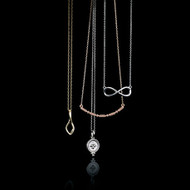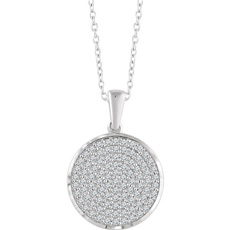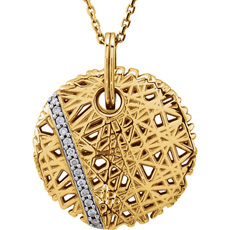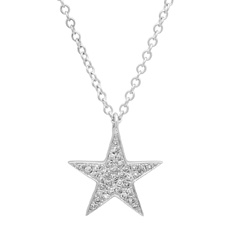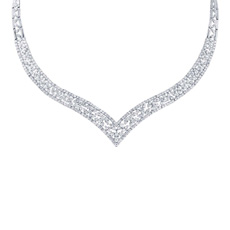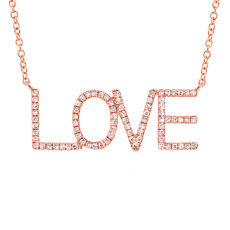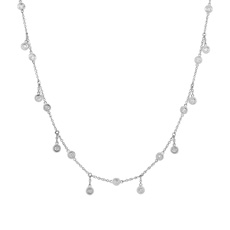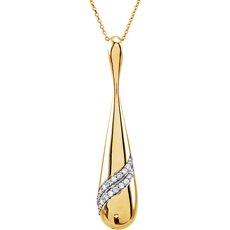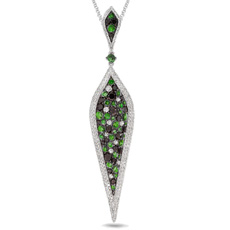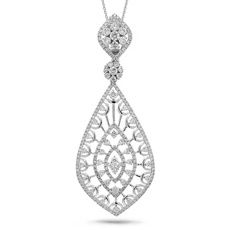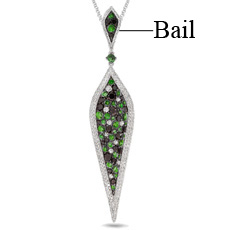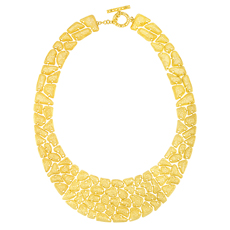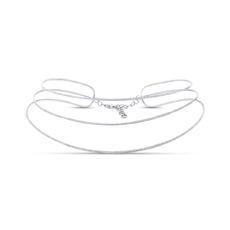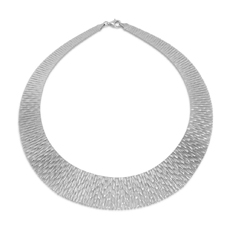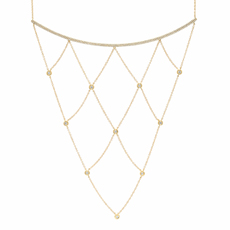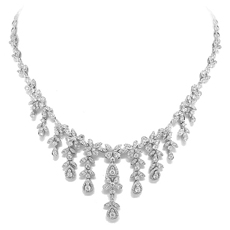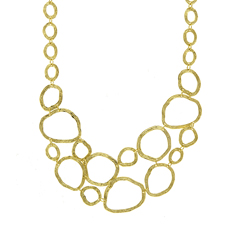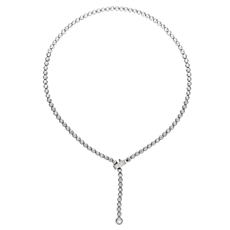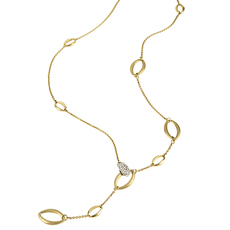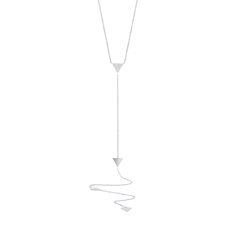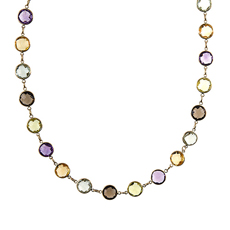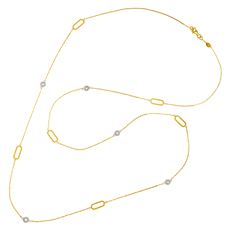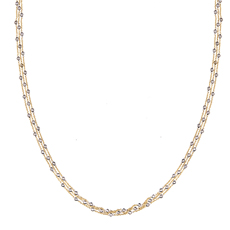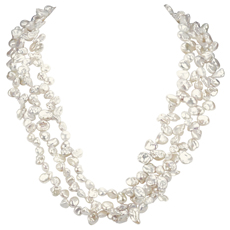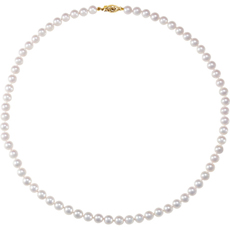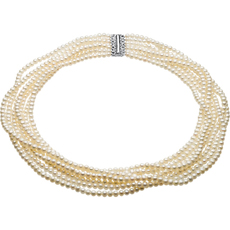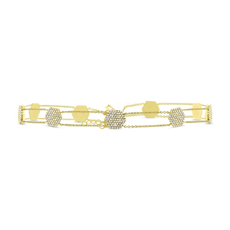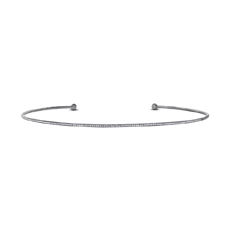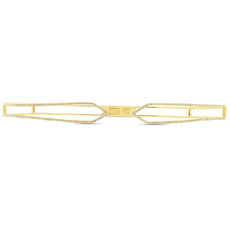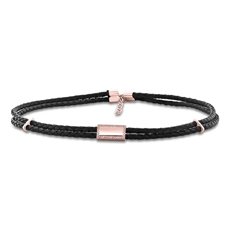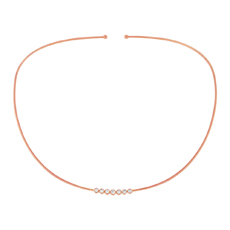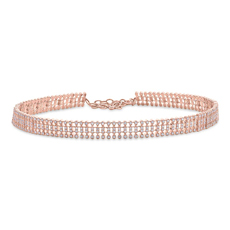The Anatomy of Pendants and Necklaces
Posted by Koorosh Daneshgar on Jan 24th 2018
What are the parts of a pendant called?
Now we get into some of the more complex aspects of jewelry. While there are millions of ring styles, the breakdown of their anatomy is universal. Necklaces and pendants have varying parts and components that can be different based on the style in question. So, in this post we will discuss a variety of topics revolving around necklaces and pendants, including: the names of different lengths, different styles, parts and components of those styles, and other details that will help you determine your ideal style of necklace.
What is the difference between a pendant and a necklace?
Many people do not recognize the difference between a pendant and a necklace. A pendant goes on a necklace, but a necklace does not need a pendant. A pendant is a decorative adornment that is worn on a necklace in a variety of s tyles. A necklace is a piece of jewelry that wraps around the neck. Pendants must be removable from a necklace to be considered a pendant. If it is not removable, it is part of a necklace.
Pendants
Necklaces
Necklace Lengths
Necklace lengths refer to the length of the chain/necklace as it wraps around your neck and excludes pendants, drops or any adornments. Most necklaces referred to in these lengths are not worn with pendants, however, there are exceptions to every rule. Many necklaces in jewelry can be adjusted to be worn at varying lengths, however, listed here are going to be the classic lengths and the terms you may frequently hear them referred to (staring from shortest to longest).
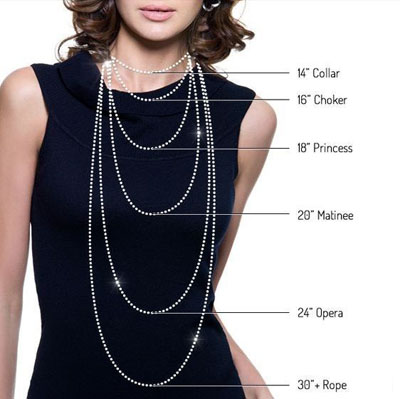
Collar/Choker
Many people tend to separate these two styles, however, in today’s jewelry market, the names are almost interchangeable. A collar is traditionally a stiff metal necklace that fits snugly around the neck and is usually held in place by it’s length and the rigidness of the metal. A choker is traditionally a similar length necklace that is usually flexible but is also made to wrap closely around the neck. These necklaces are traditionally between 12-16 inches depending on style and the thickness of a person’s neck.
Princess Length
Princess length is the most frequently used length in the jewelry industry. Traditionally between 16-18 inches, the necklace usually falls just below the collarbone, depending on the wearer.
Matinee Length
Matinee is a length of necklace that is traditionally between 20-22 inches and traditionally falls right at or above the bust.
Opera Length
Just like “opera length gloves” this title is given to something that is long and glamorous. A less commonly used length of necklace, between 24-28 inches.
Rope Length
What do you conjure in your mind when you hear a rope? Likely a long continuous strand. Well, that is what you can expect with a rope necklace, it is a length that is 30 inches or can even exceed those lengths. This length can be worn as a single strand that can drop down as low as the navel, or be worn as a double wrapped necklace.
Follow us on Instagram and Facebook for more designs and tips.
Pendant/Necklace Styles
These styles can contain a wide range of variations. However, these styles tend to incorporate many different variations in the jewelry industry. We won’t be discussing different chain styles, because that is a post for another day.
Riviére Necklace (Also referred to as: Tennis Necklace)
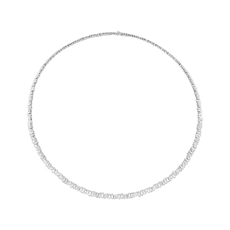
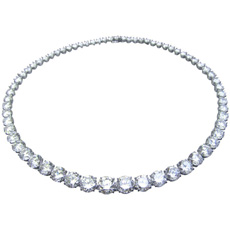
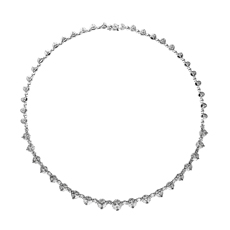
A riviére necklace style traditionally features a single row of gemstones that go around the neck. Rivére necklaces can come in a variety of lengths, metals, and setting styles. The necklace can feature a line of stones in a variety or graduated size, or a single size (commonly referred to as a tennis necklace).
Parts of a riviére
Prongs/Basket/Links
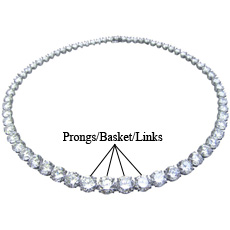
Riviére necklaces come in a variety of styles, a common theme you will see whenever we discuss jewelry: there are no rules to style. Therefore, links can be the classic basket style or something infinitely more decorative. More often than not, stones are secured by prongs, regardless of the style of link.
Pin & Hinge
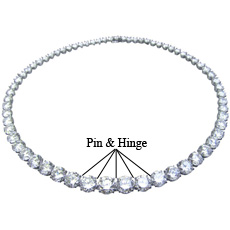
Since riviére necklaces are flexible, there are usually hinges between individual links. The axis is comprised of a small metal pin and hinge that allows approximately 90 degrees of motion allowing for flexibility.
Clasp
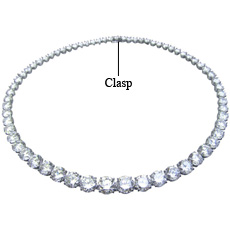
The clasp is a general term for any mechanism that secures and closes a necklace. There are a variety of styles of closures that can be used in necklaces, so I will focus on styles that are most frequently used for each style of necklace. Due to their weight and value, riviére necklaces tend to feature very sturdy clasps: barrel/tongue and groove clasps and lobster clasps.
- Tongue and Groove Clasps (Also referred to as: Barrel Clasp)
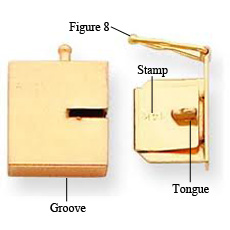
Tongue and Groove clasps come in a variety of shapes and designs, however, the basic design of them is standard regardless of decoration. The basic components of a tongue and groove clasp are the tongue, groove, and figure 8. The tongue slides into the groove, locking into place due to the tension of the metal as it pushes up on the groove. The figure 8 latches on to a peg on the other side of the clasp ensuring its security. Very frequently, stamps will appear on clasps as the largest flat surface of metal.
- Lobster Clasps
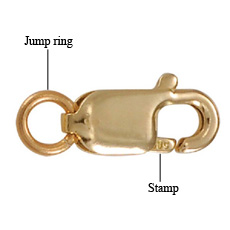
Lobster clasps get their name because of their resemblance to a lobster’s claw. They are secured to a necklace (or bracelet) with a jump ring.
Lavalier (Also referred to as: pendant, drop pendant, chandelier pendant.)
The lavalier is the pendant you are likely most familiar with. It is a decorative piece of jewelry designed to be work on a necklace. It is by far the most common style and can come in millions of designs an can range from a modest solitaire pendant (discussed later), to more intricate designs like those pictures above.
Parts of a lavalier
Bail
The only technical part of all pendants is the bail. The bail is the part of metal that the chain feeds through. There are many different types, but can be broken down into four distinct categories: tube bails, clip-on bails, fixed bails and hidden bails.
- Tube Bails
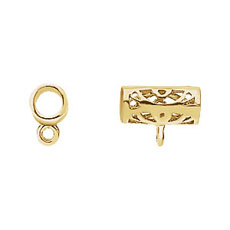
The Tube bail, as the name would suggest, consists of a tube that connects to the top of the pendant allowing the chain to feed through it. The tube can be decorative (like the image above) or a simple metal tube.
- Clip-on/Necklace Bail
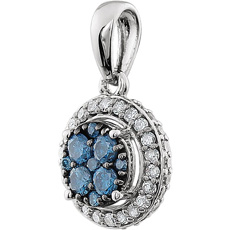
This bail is is soldered closed at the top of the pendant or attached without being soldered to the pendant itself. The bail is not fixed onto the top of the pendant allowing movement between the pendant and the bail. Bails like these are the most common and can come in a million different styles. They can be decorative or simple, embellished or plain.
- Fixed Bail
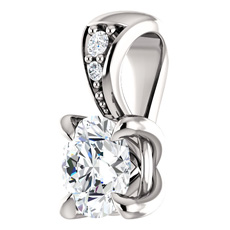
A fixed bail is exactly what the name would suggest. The bail is fixed onto the pendant and, like the clip-on bail, can be decorative or minimalistic. The most common variation of the fixed bail is a rabbit ear bail which splits the bail down the middle making the bail look like its namesake.
- Hidden Bail
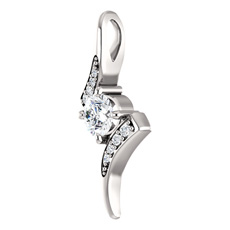
The hidden bail almost can’t be called a bail. The hidden bail is built into the pendant. It gets its name because traditionally it is hidden from view in the design of the pendant, allowing the chain to feed through the pendant itself.
Slide
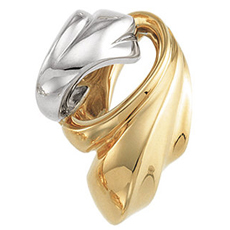
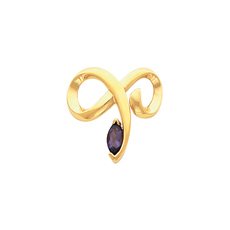
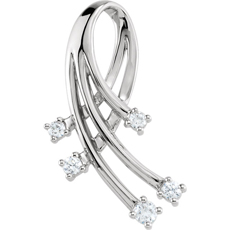
The slide pendant is a style that is most frequently worn with omega necklaces and neck-wires. They wrap around he necklaces and are meant to be worn loosely. Because the pendant is traditionally made as a single pieced wrapped around the chain, they rarely have individual parts and components.
Follow us on Instagram and Facebook for more designs and tips.
Bib/Cleopatra Necklace
Cleopatra
Bib
These two styles had to be combined for the purposes of the discussion in this blog because a Cleopatra necklace is a bib necklace, however, not all bib necklaces are Cleopatra necklaces. Bib necklaces are necklaces that have a large piece, or multiple pieces that drape down the front like a bib. The Cleopatra necklace drapes down the front and tapers around the neck and gets the name from its similarities to jewelry frequently attributed to the Queen of the Nile. These necklaces can come in a multitude of styles: solid metal that wraps around the neck, diamonds, decorative metal or gemstones.
Parts of a Bib/Cleopatra
The parts of a bib or Cleopatra necklace differ greatly determined by the style of the necklace. However, the parts of the necklaces are very similar to that of riviéres: links, clasps, and sometimes pin and hinges.
Clasp
- Toggle Clasp
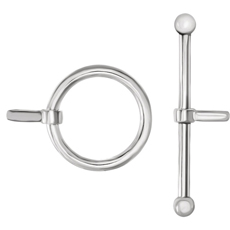
One of the only clasps that you may find on bib or Cleopatra necklaces that differs from other styles discussed before is a toggle clasp. The toggle clasp features a bar that fits through a loop on the other end. The width of the bar prevents the bar from being pulled through the loop without human interference. Toggle clasps are a great, secure, clasp that also provides decoration for whatever it is securing. Toggle clasps can, like most jewelry, run the gambit from simple and elegant, to decorative and gemstone encrusted.
- b.Spring Ring
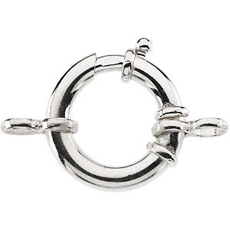
The spring ring is a clasp that, when small and petite, is not known for it’s security or its ability to operate and therefore are not typically used on heavier necklaces like riviéres. However, larger variations of spring rings can be secure and easier to operate. Spring rings are typically simpler but can be larger and more decorative like the spring ring pictured above.
Lariat (Also referred to as: Bolo Necklace)
The lariat style of necklace is a simple style with many varieties. The classic lariat style is a necklace that does not clasp and is meant to feed one end of the necklace through the other end and worn draped down the front in a Y-shape. Because the necklace isn’t clasped or fixed, traditional lariats are meant to be adjustable in length. Modern variations of lariat necklaces are necklaces that have that traditional Y-shape but may be fixed and placed around the neck and clasped in the back. Another style that has recently gained popularity is the bolo necklace. This style gets its name from the popular bolo tie. The necklace features the traditional lariat shape with a clasp in the back and an adjustable length in the front, similar to the bolo tie. Because lariat styles are traditionally smaller and daintier, the clasps used are smaller clasps like spring rings and lobster clasps. Outside of their embellishments and clasps, lariats do not really have any specific parts or components that differ from other styles on our list.
Station/Tin-Cup
Station
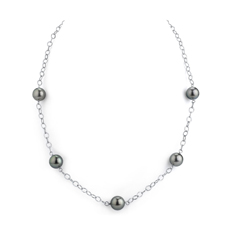
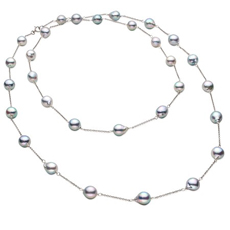
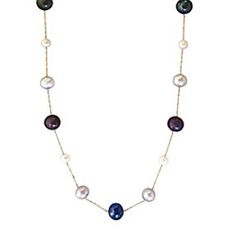
Tin Cup
The station necklace is a very beautiful style necklace for someone who wants just a hint of design. The name describes a style that has a delicate chain with any kind of accent or gemstone spaced around the chain. The Tin Cup necklace is a station necklace but with pearls. The tin-cup necklace gets its name from the 1996 movie Tin Cup starring Rene Russo. Rene Russo wears a necklace of this style throughout the movie and the style took off. Station necklaces can come in a variety of styles and especially lengths. They can be worn choker style, or even opera length and can be wrapped multiple times around the wearer’s neck. There are no parts or components on a station necklace that differ from other necklaces previously discussed. Because the chains on station necklaces are very thin and dainty, they usually have very small and dainty clasps.
Pearl Strands
The pearl strand is probably the simplest and most classic style of necklace on this list. The name says it all. Pearl strands can be simple single strands or pearls in varying shapes, sizes and colors, or there can be multiple strands like the styles shown above.
Parts of a Pearl Strand
Clasp
- Pearl Clasp
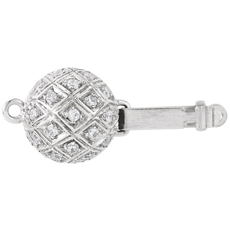
While you may occasionally come across pearl strands with springs rings, or lobster clasps, the traditional clasp on pearl strands is a variation of tongue and groove clasps most frequently called a pearl clasp with rings at either end allowing pearl strands to be tied securely to the clasp. The pearl clasp differs slightly from the traditional tongue and groove clasp because it hooks around a peg before locking in place adding an additional level of security.
Choker/Collar
Collar
Choker
Chokers and collars are the only necklaces that find themselves on both the length and style lists. This is because chokers have become one of the most sought-after styles of neckwear in the jewelry industry. While many of the styles listed above can be worn in a choker or collar length, the choker and collar styles have become styles of their own. As discussed above, choker and collar necklaces are meant to be worn close to the throat, hence their namesake. Like all necklaces, they come in a variety of different designs and styles made with varying adornments and materials. Their parts and components vary based on design but are not different from any styles discussed throughout this post.
Are these all the styles?
Of course not! This is just a list and overview of the most frequently seen styles found in the jewelry industry. I feel I say this with increasing frequency, however, the lines between these styles are not cut and dry. You can have a tin cup collar necklace, or a station lariat necklace, or even a lariat riviére. As with all jewelry, there is no end to the designs you can imagine!
With so many designs and styles, how will I know what looks best on me/my partner?
This is a fair question; however, it is a question that is impossible to answer. Like choosing clothing, cars or shoes, it is best to try them on and see if you like the way they look. So, get out there and try on necklaces, see what style appeals most to you and what you think looks best on you.
Why should we come to you to design my necklace or pendant?
We involve you in every step of the process. We will first sit down with you and go over any concerns you have and any specific design elements you want your jewelry to have. Once we have established exactly what you want the piece to look like, we will proceed with the design process. Once you see this design, if you want to make any changes, or if you have any questions or concerns we will be happy to address them for you. Our role is to help you create the perfect piece of jewelry and that means we will listen to you and make sure that your jewelry is truly one of a kind.
We'll help you to design your dream engagement ring without stress and spending countless hours searching for your perfect ring. All you need to do is click on "Free Consultation" to get started.
By: Koorosh Daneshgar CEO/Design Chief
Email: Koorosh@WeddingBandscompany.com
Phone: 312-920-0726
Business Text Message Line:312-785-8333

